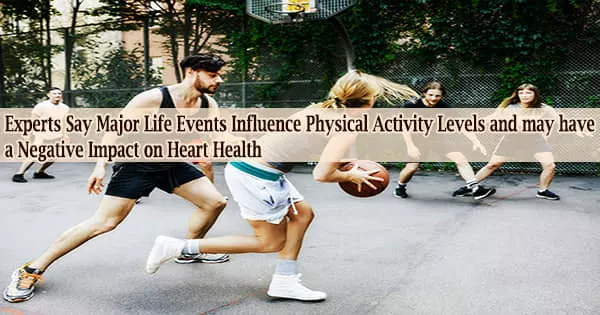Starting a new school or career, having a kid, or retiring are all important life changes that can have a considerable impact on a person’s physical activity level, potentially resulting in poor heart health.
A new American Heart Association Scientific Statement published today in the Association’s flagship publication Circulation advises individuals and health care professionals to be proactive in addressing this condition. A scientific statement is a professional review of current research that may help to shape future guidelines.
The statement, titled “Supporting Physical Activity in Patients and Populations During Life Events and Transitions,” emphasizes the importance of learning more about how life changes affect physical activity levels and what can be done to help people maintain good heart health as they go through life transitions.
Because sedentary behavior is an emerging cardiovascular disease risk factor, members of the statement writing group emphasize the need of understanding how physical activity levels may affect health during major life events and transitions.
The statement also instructs health care practitioners on how to recognize, handle, and promote regular physical exercise in individuals who are going through substantial life changes. There are various options for community-level initiatives to promote physical exercise.
“Certain life events and transitions may mark the beginning and end of different phases of a person’s life, and these life changes may lead to periods of less physical activity and more sedentary lifestyle behaviors. Physical activity is an important heart-healthy behavior and too much sitting and inactivity is not good for you,” said the writing group Chair Abbi D. Lane-Cordova, Ph.D., FAHA, an assistant professor in exercise science at the Arnold School of Public Health at the University of South Carolina in Columbia South Carolina.
“This is a particularly important topic right now because, in addition to life’s other major events, the COVID-19 pandemic is another disruption of everyone’s daily routines and activity levels.”
Most individuals should engage in at least 150 minutes of moderate-intensity aerobic activity or 75 minutes of strenuous aerobic activity per week, or a combination of the two, spaced out throughout the week, according to the American Heart Association. Every day, children and adolescents aged 6 to 17 should engage in at least 60 minutes of moderate-to-vigorous physical activity.
It’s important to maintain or improve physical activity when major life events happen, which is often a time when exercise is most needed. There are so many ways people can do this. They could plan family activities that involve exercise, use free videos or websites to exercise at home or take standing breaks while at work. The most important things are to be aware of the positive health and cardiovascular impact of physical activity and make the effort to get moving.
Lane-Cordova
According to the US Centers for Disease Control and Prevention’s Office of Disease Prevention and Health Promotion’s “Healthy People 2020” initiative, only about 1 in 5 teens (20%) and 1 in 4 adults (24%) in the United States met the recommended levels of physical activity on a regular basis in recent years.
While these rates are generally low, data suggests that they could vary dramatically during a big life event or transition. The research team looked at data from 17 major life events or transitions and discovered evidence of lower activity for nine of them:
- Beginning a new school (elementary, middle, high school or college) each distinct life events;
- a first job or career change;
- a marriage or civil union;
- pregnancy;
- parenting;
- retirement; or
- moving into a long-term care facility.
The writing group also looked at the consequences of big life events on different sections of the US population to see who needed the greatest help during these times. People most at risk for significantly lower physical activity during life changes include:
- individuals with lower levels of education;
- those who lived alone during the initial COVID-19 venue closings;
- those who lacked safe access to outdoor space for exercise and physical activity; and
- women during pregnancy and parenthood.
The “socioecological model,” which takes into account human, societal, environmental, and policy issues, was utilized to look into a variety of factors that influenced physical activity levels.
The analysis found that general factors affecting physical activity levels among youth (<18 years of age) at the individual level include:
- gender;
- age;
- motor coordination;
- time outside;
- physical activity preferences
- body image;
- perceived barriers;
- involvement in school sports; and
- physical education.
Youth were influenced by their weight and physical activity levels, as well as their parents’ educational degree, on an interpersonal level. Neighborhood crime rates, perceptions of safety, walkability, proximity, and access to school programs and recreational amenities were all environmental influencers for youth.
COVID-19-related restrictions and stay-at-home orders have also been linked to changes in youth physical activity, and Lane-Cordova believes that additional research is needed in this area.
The analysis of physical activity levels for adults (18+ year old) found individual influencers included:
- the perceived health benefits of exercise;
- history of and intention to exercise;
- self-efficacy/confidence to achieve goals;
- enjoyment; and
- lower stress levels.
Adults were influenced by social and cultural norms in both positive and negative ways, whereas environmental factors included proximity to recreation facilities and greenspaces, transportation, neighborhood walkability, and convenience.
The statement proposes future work to discover socioecological elements that may assist support routine exercise because research on factors affecting physical activity during life transitions is lacking.
Safer streets for walkers and cyclists, rail-to-trail projects, and park enhancements are examples of these variables. The writing group suggests public health strategies to achieve these infrastructural modifications, which would help to ensure that physical activity is supported during significant life events.
The declaration also offers health-care practitioners practical suggestions for promoting regular physical activity levels during important life events and transitions. During a typical health visit, health care practitioners can assess physical activity by asking a few questions as part of the collection of vital signs.
In a clinical environment, a brief screening instrument with questions for specific patient responses could be a low-cost option for assessing physical activity levels and needed support. The writing group recommends that patients utilize basic, commercially accessible wearable devices such as pedometers or accelerometers to track their physical activity levels and changes on a regular basis. Simple metrics like increasing regular physical activity levels by 1,000 steps per day may result in enhanced health benefits.
“It’s important to maintain or improve physical activity when major life events happen, which is often a time when exercise is most needed,” Lane-Cordova said. “There are so many ways people can do this. They could plan family activities that involve exercise, use free videos or websites to exercise at home or take standing breaks while at work. The most important things are to be aware of the positive health and cardiovascular impact of physical activity and make the effort to get moving.”
The remark implies that health care professionals have a significant role to play in bringing up the topic of physical activity levels with their patients. Health care workers should focus on compassion and understanding, according to the writing group.
Because primary care physicians may not have the time or resources to provide follow-up treatment, clinicians may consider enlisting the help of other members of the clinical care teams, such as nurses, medical assistants, and health or lifestyle coaches.
Behavioral counseling is also mentioned as a way to provide support for physical activity through big life transitions or events, according to the statement. Starting and maintaining regular physical activity through big life events and changes has numerous mental and physical health advantages. Encouragement of regular physical activity, as well as compassion and understanding, is beneficial to physical and mental health during difficult times.
Health care workers, according to the statement writing group, maybe a valuable source of encouragement. A patient’s confidence in their capacity to incorporate regular physical activity into their daily routine may be boosted by referring to previous accomplishments.
During life transitions and events, motivational interviewing may be more effective than a more typical educational approach. Physical activity counseling can also be provided by a range of health care professionals, such as physician assistants and health or lifestyle coaches.
The writing group said it is crucial “to look beyond the health care setting and engage organizations, communities, workplaces, faith-based communities and assisted living facilities to promote physical activity.”
Individuals and health-care professionals will find a list of resources in the statement, many of which are free and available online. According to the writing group, future research should focus on improving surveillance efforts to monitor physical activity, sedentary behavior, and the resulting overall health and wellness, particularly among at-risk and underserved communities.
More data is also needed to accurately assess the effects of life events and transitions on sedentary behavior, particularly given the rising body of research linking excessive sitting to poor health consequences. Finally, the statement emphasizes the importance of developing and testing interventions that target specific life events and transitions that are connected to decreased physical activity levels.
















